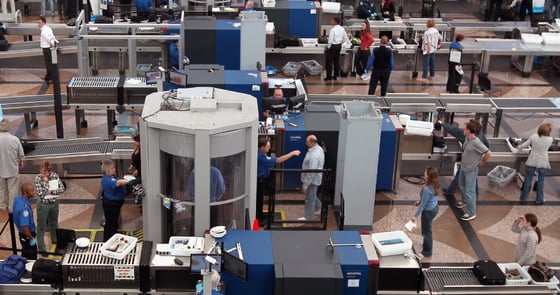Collaboration solutions for the modern workforce are focused more and more on enabling the mobile workforce, and why should security be any different? Today’s workforce is digitizing rapidly with more and more companies’ business model reflecting trends like mobility and “bring your own device”. The exponential growth of online devices is expected to grow from 15B today to 500B by 2030. With increased digitization comes security advancements and an increased need for networks security.
Many of today’s technology customers have invested in a layered security approach – combining multiple mitigating security controls to protect resources and data. A layered network security approach is really looking at all the attack vectors and correlating what you find in a meaningful way that allows you to determine if vulnerabilities have reached different parts of your network.
Layered security can be explained with a comparison to airport security (for technology laymen like myself):
When you get to the airport there are multiple security checkpoints:
- Ticketing Counter
- Show ID to verify you are who you say you are before getting your ticket and checking bags
- Security
- At the security checkpoint, you show your ticket and ID again
- Any carryon bags are scanned and checked for hazardous/ dangerous materials
- Your persons is also scanned and checked for hazardous/ dangerous materials
- Gate Agent
- Once through security your ticket is scanned again at the gate your flight departs from before boarding the plane
- Backend monitoring
- Air traffic control preventing crashes and monitoring take offs and landings
- Extensive visibility using closed circuit cameras
- Airport personnel (pilots, custodian, security, tarmac employees, mechanics) who are trained to be more aware and vigilant than day-to-day travelers.

Many customers have warmed up to this approach of network security, layering VPN, firewalls, antivirus software, web and email security, and management tools to secure the network. With today’s new technologies more and more customers are leveraging the power of the cloud to enhance security measures, but they still lack endpoint visibility for their network. With guests and contractors frequently coming into the office there is still this on-going struggle with endpoint visibility.
In this age of digitization, we are seeing increased opportunities for hackers, and are hearing more and more that customers’ primary visibility concerns are hinged around shared access (physical network access in common areas of an office such as the lobby or conference rooms). Network access controls are nothing new. These controls recognize each user and each device allowing you to enforce security policies and block, or limit, access of any noncompliant endpoint devices. Traditionally posture assessments have been used to determine user/ device access. The first approach we have seen customers take with these assessments is a “red light/ green light” approach. This means if you are recognized as a corporate device you are granted access to the corporate network, but if you are recognized as an untrusted device you are granted access as a guest to the internet only.
Today’s visibility solutions go deeper than the “red light/ green light” approach and can provide levels of access based not only on who is attempting to access the network but, what department they are in, their position and even what device they are using. For example: In a company the accounting department needs access to the financial server, however the sales department do not need access to that server.
On the other end of the spectrum we are seeing increased for the need of remote visibility. In the past when a corporate device left the network employees were having to VPN back in to gain access. The VPN method causes a backhaul of all remote traffic to one corporate security center, which causes loss of efficiency. As I mentioned before with new technologies continually emerging we are seeing more and more customers leverage the power of the cloud to augment their network security and increase both on premise and remote endpoint visibility.
With an ever-growing mobile workforce, the need for endpoint visibility within your network is becoming a greater necessity and concern for customers. Using a layered security approach will improve the depth of the protection for your network. Leveraging new cloud enabled technologies will ensure users security wherever they go, and will increase your visibility to where users are going and what they are doing. There is no “silver bullet” to protecting your network. However, increasing your network security and visibility should leave you feeling confident that you have minimized your vulnerability.
Written By: Eden Penman, LookingPoint Marketing Coordinator



